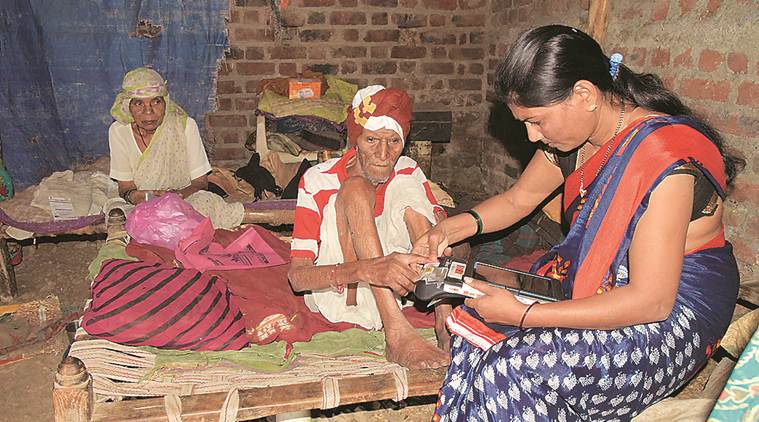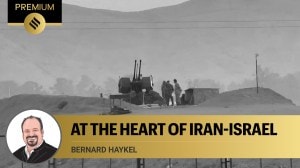- India
- International
In Maharashtra’s Wardha villages, banking means ATMs coming home
Transactions of over Rs 42 crore since micro-ATM scheme for financial inclusion was launched in district in 2017.
 Banking Correspondent Sangita Kamble at work. (Express photo by Deepak Daware)
Banking Correspondent Sangita Kamble at work. (Express photo by Deepak Daware)
MAHADEORAO Fating is over 90, his wife Parvatabai close behind. The couple, who rarely move out of the tin-shed home in Waigaon village in Maharashtra’s Wardha district, sustain themselves with the Rs 600 a month that each gets under the state government’s Shravanbal Yojana for elderly destitutes. Once in three months, the money gets deposited in their local State Bank of India branch. There’s no way they can make that visit, so the bank comes to them — in the form of Sangita Kamble and her micro-ATM.
Kamble, 40, is a banking correspondent (BC) who takes banking solutions to the doorsteps of the Fatings and several others in their village. She is one of 115 BCs appointed under the Wardha district’s Aaplaa Aadhaar Aapli Bank (Our Aadhaar, Our Bank), an Aadhar-linked banking scheme in villages that either have no banks or where people have difficulty getting to banks.
Started in November 2017, the scheme has seen 1,59,787 transactions worth over Rs 42.55 crore in Wardha — so far, 11 of the 115 BCs have recorded transactions of over Rs 1 crore each. The BCs, most of them drawn from local self-help groups in Wardha, are trained by IDFC First Bank to operate the micro-ATM machine and carry out transactions. These include withdrawals and deposits, utility bills, pension and scholarship, mobile or TV recharge, and opening new accounts.
All that customers have to do is approach the BC with their Aadhaar numbers — in the case of the elderly and infirm, the BCs carry out home visits — let the machine scan their biometrics and ask the BC for the money to be withdrawn or deposited. After each such transaction, the machine releases a slip and sends a message to the customer on her mobile.
Each BC gets Rs 5,000-Rs 7,000 depending on the transaction, including commissions and a monthly honorarium of Rs 3,000 from the Maharashtra State Rural Livelihood Mission (MSRLM).

In a bid to make BCs stakeholders, it was decided that they would invest in the micro-ATM. “The machines costs Rs 50,000 each but MSRLM made them available to the BCs for Rs 10,000, of which the Wardha District Planning and Development Committee (DPDC) pays Rs 7,500 while the BC has to pay only Rs 2,500,” says Siddharth Bhotmange, District Manager, Financial Inclusion, MSRLM.
Besides, the BCs use their own money for the transactions — if they run out of cash, they use their IDFC Bank debit cards to replenish it.
Nationwide, there has been a significant rise in the penetration of this banking model over the last eight years. While the branches in villages have grown from 33,378 in March 2010 to 50,805 in March 2018, the outlets through BCs in villages have grown over 15 times from 34,174 to 5,15,317 in the same period. Even in urban areas, the number of locations covered through BCs has jumped from just 447 in 2010 to 1,42,959 as of March 2018.
Back in Wardha, Kamble, who has studied up to Class 12, has done 16,390 transactions worth Rs 4.79 crore since November 2017, when the scheme started. About 60 km away, at Pimpri village in Karanja Ghadge tahsil, Sunita Devase, 34, is a BC for 7-8 villages. A member of a self-help group, Sunita has so far done 8,448 transactions worth Rs 1.61 crore. “I am just a Class 12 pass. Earlier, I could do no bank work. Now you name a transaction and I can do it on my machine. This has given me a lot of confidence… that I too can do something worthwhile,” she says.
Talking of how IDFC Bank has opened 600 new accounts since the programme began, its regional coordinator for Vidarbha, Sanjay Burde, says, “The bank prefers the BC mode of banking to physical branches as the latter has limitations and involves a lot of investment.”
Says Wardha Collector Shailesh Naval, “In Wardha, we have 128 bank branches, each catering to a population of about a thousand and covering 4-5 villages. But for many customers, particularly those in the interior villages, it is not only inconvenient to go to the bank but also costly. For example, if someone has to withdraw, say, Rs 500 from the nearest branch, he or she has to spend Rs 100 on travel and once at the bank, spend hours in the queue.”
Says Shrikant Barhate, former World Bank consultant and currently senior fellow, Mumbai School of Economics and Public Policy, “access points like micro-ATMs are good for two reasons. One, it reduces the cost of transaction for both the bank and the customer. And two, it greatly enhances banking literacy of the users.”
Vinayak Deshpande, economist and former acting Vice Chancellor of Nagpur University, calls the initiative “impressive”. “This story is an indication of how to move from the bank-branch model to the branch-less banking model. Of course, there is a need to provide basic education and create awareness about online security,” he says.
Must Read
Buzzing Now
Apr 20: Latest News
- 01
- 02
- 03
- 04
- 05







































